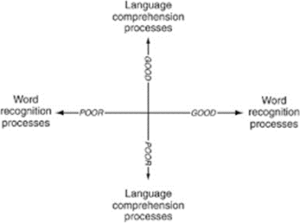Comprehension is the ability to understand. In reading it’s the term we use to talk about children’s understanding of texts. Whether you’re an experienced or inexperienced teacher, you’ll know that teaching reading comprehension is one of the most challenging aspects of literacy. In this article I set about sharing my advice for getting the most out of comprehension lessons.
1. Understanding that Reading is a process of two parts
In 1986 Gough and Tunmer presented a model of reading called The Simple View of Reading. As a model, it’s a simplification of a very complex process. Reading really isn’t simple but it’s a very useful model for considering the two over-arching principles involved in reading: the ability to decode text (word recognition processes), and the ability to understand what has been read (language comprehension processes).

The above is is a useful model to assess the children in your class. Ideally, they would all be placed in the top right-hand quadrant (good word recognition, good language comprehension). If you’re able to assess the children in your class as belonging in this quadrant you can be confident that you can continue with your usual reading programme without having to make any adaptations.
It’s likely though that the members of your class will occupy the other quadrants too. It’s worth doing this because depending on where you place them, you can then ascertain what type of support and intervention they might need.
Top right-hand quadrant | Good word recognition, good language comprehension | No intervention required |
Bottom right-hand quadrant | Good word recognition, poor language comprehension | Language comprehension support required |
Top left-hand quadrant | Good language comprehension, poor word recognition | Word recognition support required |
Bottom left-hand quadrant | Poor language comprehension, poor word recognition | Language comprehension support required |
2. Get started on comprehension as soon as you can
In English schools Systematic Synthetic Phonics is used as the primary approach to teach children to read. This is a research-informed policy that ensures children are taught to recognise and blend phonemes to decode efficiently and effectively. Of course, phonics is just one side of the Simple View of Reading and no matter how much phonics tuition you give to children it will not teach them language comprehension skills. Which is why even the youngest children need to experience language comprehension teaching as soon as they start learning to read.
3. Encourage talking about texts
Understanding what you read is one thing. Articulating your understanding as a written response, is quite another. Children find giving writing their responses to comprehension questions extremely challenging. So, what can we do to help them? In the first instance, we need to encourage talk about texts. When children work together to talk about a text, they have the chance to think out loud, to listen to other responses, to alter their initial thoughts and come to a collective understanding about a text. Talking about texts enables them to build the confidence to eventually respond to questions independently.
4. Model thinking like a reader
Modelling is one of the most powerful teaching tools we have. As teachers we are the expert readers in the room and modelling our understanding of texts is one of the most beneficial activities we can undertake. Displaying an enlarged text or providing children with copies of the text you are going to read is the starting point for modelled reading. You then need to read the text aloud and talk out loud about the techniques the author is using and how they’re helping you comprehend what you read. I like to use phrases such as I wonder… (I wonder why the author used that word…I wonder if that’s a clue I should remember…I wonder if we’ll find out more about that later…). I also like to reflect on how the text is making me feel (noting which words, phrases and ideas are giving me that feeling) and whether the text is reminding me of other books I’ve read, experiences I’ve had or my broader knowledge of the world: the connections I’m making from the text.
5. Encourage connection making
I regularly quote E.D. Hersh who said: ‘To grasp the words on a page we have to know a lot of information that isn’t set down on the page.’ I think this quotation sums up one of the greatest challenges of reading comprehension – children need to have a lot of background knowledge. Encouraging children to make those connections is vital. Some children will think it’s cheating and that they can’t use their broader knowledge and some children will have limited experiences to draw upon. As teachers of reading, we need to activate these connections; we need to arrange experiences for children, use films and videos to enrich their knowledge stores and we need to ensure that they experience a wide range of texts. This means we need to read aloud to children regularly from books that they might otherwise not choose to read, and we need to stock our classroom book corners with the best books that we can find to ensure that children experience a wide range of books.
6. Undertake creative responses to texts
Along with talking about texts and making connections to prior knowledge, children should make creative responses to what they read. By this I mean performing in role as a character from a story, writing diaries and letters from the perspective of a real-life person they’ve read about or re-presenting a story as a comic strip. Bringing their understanding of texts alive through creative responses reflects deep understanding and engagement with what they’ve read. However, there are times when children need to provide formal responses to what they’ve read, and we’ll talk about these next.
7. Build experience of answering written comprehension questions
We work in a system that measures children’s success as readers through their ability to answer questions about what they have read. This means we need to prepare children for the reading comprehension tests they will take at the end of Key Stage 1 and Key Stage 2. Answering in sentences and formulating longer structured responses are important skills children need to practise in preparation for the end of key stage tests. That said, the tests also include questions that ask children to select an answer from a given range, to rank and order information and to join information in boxes with lines. Building this full range of question types into comprehension lessons is vital if we’re to give children the opportunity to shine in the formal comprehension tests in Year 2 and Year 6.
These are just a few of my thoughts about reading comprehension. It is difficult to teach; I know that. But the rewards for getting it right far outweigh the challenges. When children understand what they read they’re more likely to find it both useful and enjoyable – and if they can achieve both of these things then all our efforts are worthwhile.

Article written by Rachel Clarke
Rachel is an experienced educational trainer and author with over 10 published titles including the popular Reading Detectives series. Rachel is now the director of the Primary English Education Consultancy; an organisation dedicated to raising standards in literacy.


